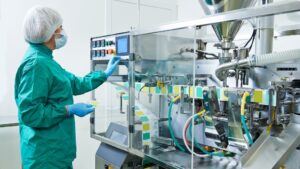
The safety and effectiveness of pharmaceutical products is critical. This is why companies must ensure a quality production process at all times. Clean environment ventilation in pharma manufacturing environments is essential for achieving this goal.
To guarantee clean air throughout the production space, you must ensure that your ventilation system is designed to efficiently capture dust particles and other airborne pollutants from the workspace. A clean environment must meet specific contamination control levels. This is measured by the number of particles per cubic meter at a specified particle size. For example, an ISO 1 room only permits 12 particles per cubic meter of diameter 0.3 μm or smaller.
By ensuring you have proper ventilation, you reduce potential risks associated with product contamination. and support a safe and clean working environment for your employees. In this post, we will discuss clean environment ventilation requirements for pharma production companies. For an analysis of your ventilation system or a quote on how to improve it, contact our experienced team today.
Effective Clean Environment Ventilation is Federally Regulated
Maintaining a clean environment in pharmaceutical production is crucial for ensuring the safety and efficacy of drugs. Clean rooms that follow Good Manufacturing Practices (GMP) contain controlled levels of air pollutants, temperature, and humidity, preventing any contamination or interference with the product. However, GMP is not the only federal regulation governing clean environment ventilation.
Other regulations include the United States Pharmacopeia or USP, the Food and Drug Administration (FDA) Code of Federal Regulations, and the Occupational Safety and Health Administration (OSHA) regulations. These regulations have specific requirements for ventilation systems, including airflow rates, filtration, and system testing. Together, they ensure compliance and maintain clean environments for pharmaceutical production.
Pharmaceutical Production Must Maintain Specific Contamination Control
In the pharmaceutical industry, manufacturers must maintain a specific level of contamination control, specified by the number of particles per cubic meter with a particular size and/or viable bacteria (CFU’s).
Colony-forming units (CFU) is a measure used in microbiology to estimate the number of viable bacteria or fungal cells in a sample. The term “viable” is used to indicate that the bacteria are alive, and thus capable of growing and reproducing. This measure is particularly crucial in pharmaceutical production, where maintaining control over microbial contamination is fundamental for product safety and efficacy.
Meeting the contamination control requirements requires complex calculations and an understanding of ventilation design principles. Air velocity, duct size, filtration rating, filter type, system pressure drop, and other design elements must be taken into account.
Ventilation System Components Should Work Cohesively to Control Contaminants
To ensure effective ventilation, a comprehensive system is needed. This system should successfully address elements such as airflow, filtration, and room air pressure.
Common components of this system may include a combination of the following, depending on your decontamination requirements:
- Air curtains
- Dust collectors
- Dehumidifiers
- Filters
- Cooling coils
- Fans or blowers
- Dampers or louvers
- Ventilation or fan silencers
With a well-designed and implemented ventilation system, pharmaceutical companies can produce high-quality products that are both effective and safe.
Clean Ventilation Helps Prevent Contaminated Products
When it comes to pharmaceutical production, there’s no room for error. Tainted or contaminated drugs can have devastating effects on patients, which is why it’s crucial for companies to employ best practices to reduce environmental contaminants. Clean environment ventilation plays a vital role in achieving that goal.
By ensuring that the air circulating within a facility meets stringent standards for cleanliness, companies can minimize the risk of contamination and reduce the liability for serious legal issues. The importance of clean ventilation in pharmaceutical production can’t be overstated, as the consequences of failing to do so are too high.
Expert Clean Environment Ventilation Design by Eldridge
At Eldridge, we take your needs seriously and put our expertise and experience to work for you to deliver a system that meets the most exacting requirements.
From comprehensive analysis to designs that use the highest quality components, your project will be done with expertise and efficiency. Contact us now for all of your ventilation system needs.
